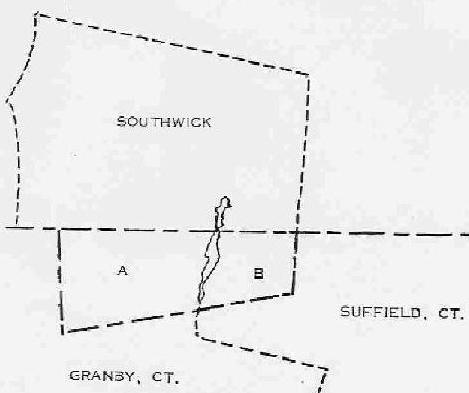Follow the border between Connecticut and Massachusetts westward and you’ll notice a little notch in an otherwise straight line. Many call this 2-1/2 mile dip the Southwick Jog after the town that plugs the hole.
The ultimate authority and definitive source is “The Southwick Jog” by Rev. Edward R. Dodge, as appearing in Southwick, Massachusetts 1770-1970. A portable document format (pdf) copy of this chapter is available through the Town of Southwick Massachusetts website. It includes fifteen pages of fully sourced and footnoted material, but it’s quite readable. Another summary but with considerably fewer pages is available through the Connecticut State Library.
A Brief Synopsis
The border remained largely undefined during early colonial times because it didn’t matter. It only became an issue once people began to settle there in greater numbers, particularly as pocketbook issues such as taxation forced it to the surface.
Massachusetts commissioned a border survey in 1642 to resolve the confusion. Its charter specified a southern border stretching completely across North American due west “from a point three miles south of the most southerly branch of the Charles River.” Easy, right? Just find that specific point south of the Charles River and start walking west.
Bad Results
Well, Massachusetts didn’t hire the most diligent bunch. Their surveyors found the first point below the Charles easily enough but then they took a shortcut. Rather than walk the line they sailed over to the Connecticut River and traveled upstream to the corresponding latitude. Here they marked a second point. Then they simply drew a line across the two dots and called it a border. That would be fine theoretically, but instruments of the day lacked a certain precision. The surveyors really needed to follow the line taking measurements as they went, because their results were up to seven miles south of the true line. Massachusetts didn’t mind, though. The error was in their favor.
They were sober despite what legends imply. They were either incompetent or lazy, and Connecticut was less than pleased with the result. So Connecticut commissioned an overland survey in 1695 that quickly revealed the error. Now there were two lines, no agreement, and a number of towns stuck in between that didn’t know who ruled them.
More Squabbling
Additional surveys, compromises, joint commissions, negotiations, repudiations and the like happened for the next hundred years.
Massachusetts gave up Suffield, Enfield and Woodstock during one of the more promising compromises, and felt a little miffed when the solution didn’t stick. They vowed never to repeat their mistake and refused to relinquish Southwick. They dug in their heels on principle.
Finally in 1804 the parties agreed to split Southwick as a concluding compromise. Massachusetts retained Congamond Lakes and the lands to the west, while the remainder went to Connecticut. Massachusetts got its bone and a symbolic victory. The dispute ended.

A Popular Oddity
I’ve covered many strange boundaries on Twelve Mile Circle. However, this one gets lots of attention from other sources. I’m a little perplexed. Usually I have these oddities all to myself and I’m a bit possessive. Maybe it happens because it sits within the heavily populated northeastern United States? Perhaps it’s simply more visible to a greater numbers of people than any of other anomalies.
Here’s a sampling of blogs that have already covered it. And if that’s not enough, there’s even a website that sells “Take Back the Notch” T-shirts, hats, mugs & stickers.
- The Southwick Jog
- Massachusetts 351 – Southwick (this couple is trying to visit all 351 townships in Massachusetts! Bravo! Reminds me of my ongoing County Quest)
- The Southwick Jog at Connecticut Museum Quest
- That Little Notch Along The Massachusetts – Connecticut Border
On a final note, Google Street View covers some of the area. Here is a primary southern entrance to Southwick, located at the very bottom of the jog in the area surrounded by Connecticut on three sides.
Look closely and you can read the Southwick sign.
UPDATE #1: The Southwick Jog continues to generate controversy. A reader has brought to my attention an article in the October 22, 2008 edition of the Hartford Courant — Massachusetts Expecting Fees From Suffield Lake Dwellers.
UPDATE #2: I visited the Southwick Jog in 2012.

Leave a Reply